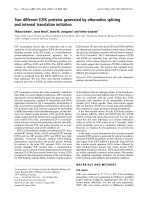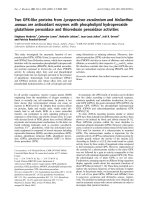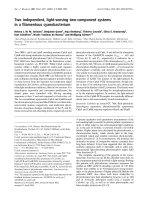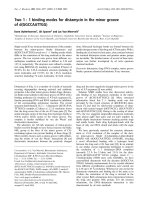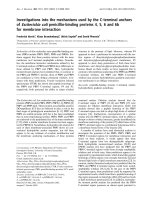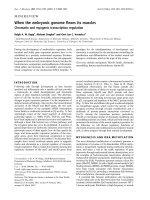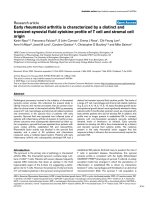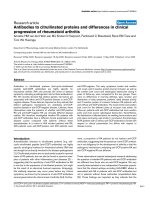Báo cáo Y học: Two different E2F6 proteins generated by alternative splicing and internal translation initiation ppt
Bạn đang xem bản rút gọn của tài liệu. Xem và tải ngay bản đầy đủ của tài liệu tại đây (219.63 KB, 7 trang )
Two different E2F6 proteins generated by alternative splicing
and internal translation initiation
Tillman Dahme
1
, Jason Wood
1
, David M. Livingston
1
and Stefan Gaubatz
2
1
Dana Farber Cancer Institute and Harvard Medical School, Boston, MA, USA;
2
Institute for Molecular Biology and Tumor Research
(IMT), Philipps-University Marburg, Germany
E2F transcription factors play an important role in the
regulation of cell cycle progression. E2F6, the most recently
identified member of the E2F family, is a retinoblastoma-
protein-independent transcriptional repressor that is
required for developmental patterning of the axial skeleton.
It has recently been shown that the E2f6 locus produces two
different mRNAs, E2F6 and E2F6b. The E2F6b mRNA
contains an additional exon that is inserted by alternative
splicing. This exon contains an in-frame stop-codon and an
in-frame translation initiation codon. However, whether a
protein is translated from the E2F6b mRNA has not yet
been addressed. We now show that internal translation
initiation gives rise to E2F6b, an amino-terminal truncated
E2F6 protein. We also show that E2F6 and E2F6b mRNAs
are ubiquitously expressed in primary mouse tissues. During
the cell cycle, the highest expression of both forms is found at
the G1 to S transition. The 5¢ untranslated regions of E2F6
and E2F6b are unusually long, and they contain several
upstream AUG codons followed by short reading frames.
Our results suggest that translation of E2F6b is initiated by
internal ribosome entry. We propose that regulated trans-
lation initiation can produce distinct E2F6 isoforms under
different physiological conditions.
Keywords:E2F;transcriptionfactor;cellcycle;alternative
splicing; internal ribosomal entry.
E2F transcription factors have been intensively studied for
their ability to control cellular proliferation. E2F-responsive
elements have been identified in genes that play key roles in
cell cycle progression, synthesis of nucleotides, and DNA
replication (reviewed in [1]). Consequently, deregulation of
E2F can promote tumorigenic transformation (reviewed in
[2]). In normal cells, E2F activity is regulated by the binding
to pRB, the product of the retinoblastoma gene, and by bind-
ing to two related Ôpocket proteinsÕ, p107 and p130. Recent
studies suggest that E2F proteins have a dual function in cell
cycle control. First, ÔfreeÕ, uncomplexed E2F is a transcrip-
tional activator with growth promoting activities. Secondly,
complexes between E2F and pocket proteins act as tran-
scriptional repressors and growth inhibitors [1].
E2F is a heterodimeric complex containing an E2F- and a
related DP- subunit. So far, six E2F proteins (E2F1 through
E2F6) and two DP proteins (DP-1 and DP-2) have been
identified. Conserved domains mediate DNA-binding,
dimerization, transactivation and pocket protein binding.
In contrast to the other E2F proteins, E2F6, the most
recently identified E2F protein, lacks a transactivation
domain, and is a pocket protein independent transcriptional
repressor [3–6]. We have recently shown that, in mice, E2F6
is required for developmental patterning of the axial skeleton
[7]. E2f6 deficient animals display homeotic transformations
of the skeleton that are strikingly similar to the transforma-
tions of certain polycomb deficient mice [7]. These observa-
tions are consistent with the recent finding that E2F6
associates with members of the mammalian polycomb
complex [8,9]. Taken together, these observations suggest
that one function of E2F6 is to recruit polycomb multipro-
tein complexes to target promoters during development.
It has been recently shown, that the E2f6 locus produces
two distinct mRNAs, E2F6 and E2F6b [10]. The E2F6b
mRNA contains the newly discovered exon 2. It has been
noted that this exon introduces an in frame termination
codon as well as an AUG codon on its 3¢ extremity, which
could potentially serve as a translation initiation codon.
However, no evidence for the generation of a protein has
been given.
In this study, we now demonstrate that an amino-terminal
truncated E2F6 protein is generated by internal translation
initiation of E2F6b. In addition, we show that the 5¢ untransl-
ated region of the E2F6 mRNA is unusually long, and that
they contain several upstream AUG codons followed by
short reading frames, features that impair normal CAP-
dependent translation initiation. E2F6 and E2F6b mRNAs
are widely expressed in primary mouse tissues. We propose
that regulated translation initiation can produce distinct
E2F6 isoforms under different physiological conditions.
MATERIALS AND METHODS
Cell culture
Cells were cultivated at 37 °Cina10%CO
2
-containing
atmosphere. Cells were maintained in Dulbecco’s modified
Eagle’s medium (Cellgrow) supplemented with 10% fetal
bovine serum (HyClone). For the cell cycle experiment,
MEF cells were serum starved in Dulbecco’s modified
Correspondence to S. Gaubatz, Institute for Molecular Biology and
Tumor Research (IMT), Philipps-University Marburg,
35037 Marburg, Germany.
Fax: + 49 6421286 5196, Tel.: +49 6421286 6240,
E-mail:
(Received 25 June 2002, revised 22 August 2002,
accepted 28 August 2002)
Eur. J. Biochem. 269, 5030–5036 (2002) Ó FEBS 2002 doi:10.1046/j.1432-1033.2002.03210.x
Eagle’s medium/0.1% fetal bovine serum for 48 h, then
released from starvation by addition of Dulbecco’s modified
Eagle’s medium/10% fetal bovine serum. The cells were
harvested at different time points after serum addition.
Synchronization was confirmed by FACS analysis.
RNA isolation
Total RNA was isolated from primary MEFs with the
RNeasy kit (Qiagen) according to the manufacturer’s
instructions. To isolate RNA from primary mouse tissues,
an adult female C57/BL6 mouse was sacrificed, and then the
organs were harvested and quickly frozen in liquid nitrogen.
Total RNA was isolated with TRIZOL (Invitrogen)
according to the manufacturer’s instructions.
Luciferase fusion constructs
We first modified the sequence around the translation
initiation of the luciferase cDNA in pGL2-basic (Promega)
by introducing an AvrII-site and thereby abolishing the
initiating ATG, generating pGL2-Avr. A fragment enco-
ding for the first eight codons of E2F6 and partial 5¢UTR
was amplified by PCR with primers SG108 and SG92 using
a genomic E2f6 clone as a template. The resulting product
was digested with BglII and XbaI and inserted into pGL2-
Avr digested with BglII and AvrII. In a second step, a 2.4-kb
genomic SacI–BglII fragment containing the remaining
5¢UTR and 2.2 kb of the E2F6 promoter was inserted to
generate Exon1-luc. A similar strategy was used to generate
Exon3-luc and Exon2-luc. We first used RT-PCR of total
RNA with primers SG92 and SG122 to amplify part of the
coding regions and 5¢ UTRs of E2F6 and E2F6b mRNAs.
PCR-products were digested with BglII and XbaIand
inserted into pGL2-Avr. Secondly, the 2.4 kb genomic
SacI–BglII fragment was inserted to generate Exon2-luc
and Exon3-luc. In Exon2-mut-luc, the translation initiation
codon was modified by PCR with primers SG92 and SG142
and Exon2-luc as a template. The resulting PCR product
was digested with BglII and XbaI and inserted into pGL2-
Avr. Finally, the 2.4 kb genomic promoter fragment was
inserted as described above. An expression plasmid for
E2F6b was generated by PCR with primers SG109 and
SG35. The PCR product was digested with BamHI and
EcoRI and inserted into pcDNA3. All constructs were
confirmed by DNA sequencing. Other plasmids have been
described previously: E1B-luc [11], E2F1-luc [12].
Polyclonal antibodies and immunoprecipitations
A polyclonal serum was raised in rabbits with KLH-coupled
peptide N-14 (CMSQQRTARRLPSLL). The antiserum
was affinity purified on columns with immobilized peptide
(Sulfolink, Pierce) and eluted in 100 m
M
glycine (pH 2.5).
The C-10 antiserum has been described previously [7]. For
immunoprecipitation, MEFs were metabolically labeled
for12–14hwith1mCi[
35
S]methionine and then lysed in
Tris/NaCl/NP-40 (50 m
M
Tris, pH 7.4, 150 m
M
NaCl,
0.5% NP-40, 1 · complete protease inhibitors (Roche),
1m
M
dithiothreitol). Lysates were incubated with 1 lg
affinity-purified antiserum. Proteins were collected on
Protein-A Sepharose beads, washed five times in Tris/
NaCl/NP-40 and then separated by SDS/PAGE.
Oligonucleotides
SG24: 5¢-GGGAATTCTCAGATAGAGTCTTCTCTGG
GAGC-3¢
SG50: 5¢-GGGGACCAGGGTGACCGCGG-3¢
SG92: 5¢-GCGCGGGAGATCTAACGGACGG-3¢
SG108: 5¢-CCTCTAGACGCGCCGTCCGGTGCTGAC
TCAT-3¢
SG109: 5¢-GGGGATCCATGCCATCAAAAATAAGGA
TTAAT-3¢
SG142: 5¢-CCTCTAGATTAATCCTTATTTTTGATGG
CCCCCTTCTGTCTCTGCCTCCCAAGGACTGGC-3¢
SG35: 5¢-CGGAATTCCCCGTGCTGGAGGCGACT
CG-3¢
SG122: 5¢-CGGACGGCGCGGAGAC 3¢
b-actin fw: 5¢-TGTGATGGTGGGAATGGGTCAG-3¢
b-actin bw: 5¢-TTTGATGTCACGCACGATTTCC-3¢
RT-PCR
RT-PCR was performed with the Superscript One-Step RT-
PCR kit (Invitrogen) with 100 ng of total RNA. For the
detection of E2F6 mRNA with primers SG122 and SG24,
the following conditions were used: 1 cycle: 30 min, 50 °C; 1
cycle: 2 min, 94 °C; 35 cycles: 30 s, 94 °C, 30 s, 55 °C;
1min,72°C, followed by 1 cycle for 10 min at 72 °C. For
the detection of b-actin, the number of cycles was reduced to
32. Products were separated on 1.4% agarose gels.
Transient transfections and reporter assays
Cells (2 · 10
4
) were plated per each well of a 24 well cell
culture dish. 24 h later, cells were transfected in triplicate
using the indicated amount of luciferase fusion construct or
empty vector and 3–5 lL of Fugene (Roche) diluted in
100 lL Dulbecco’s modified Eagle’s medium per triplicate
reaction. To analyze the transcriptional properties of
E2F6b, U2-OS cells were transfected with 0.200 lgof
E2F-dependet luciferase reporter construct (E2F1-luc or
E1B-luc), 0.050 lgofCMV-bGal (to monitor transfection
efficiency), and 0.200 lg pCDNA3-mE2F6, pCDNA3-
mE2F6b or pcDNA3-DP2 expression plasmids. Cells were
harvested 48 h after transfection and lysed in 1 · passive
lysis buffer (Promega). Luciferase assays were performed on
a Dynex Luminometer. Luciferase activity was normalized
to b-Gal activity to correct for differences in transfection
efficiency.
Primer extension
Total RNA was extracted from mouse embryonic fibro-
blasts using the RNeasy mini kit (Qiagen). SG50 primer was
end labeled with [c-
32
P]ATP and T4 polynucleotide kinase.
For the primer extension reaction, 10 lgofRNAwas
hybridized to radiolabelled SG50 at 65 °Cfor90minin
hybridization buffer (0.15
M
KCl/0.01
M
Tris/Cl, pH 8.3/
1m
M
EDTA). Hybridized RNA was then extended for 1 h
at 42 °C by addition of 30 lL reaction mix [1 lL1
M
Tris,
pH 8.3, 1 lL0.5
M
MgCl
2
,1lL0.25
M
dithiothreitol,
3.33 lL2m
M
dNTP mixture, 22.67 lLH
2
O, 1 lL1:20
diluted Superscript II reverse transcriptase (Invitrogen)].
RNA was subsequently degraded by incubating with
105 lLRNase(100lgÆmL
)1
sonicatedsalmonsperm
Ó FEBS 2002 E2F6b, an alternatively spliced E2F6 isoform (Eur. J. Biochem. 269) 5031
DNA/20 lgÆmL
)1
RNaseA)for15minat37°C. A
sequencing reaction was performed with the same SG50
32
P-end-labeled primer using Sequenase 2.0 (United States
Biochemical) and the pBS-Not/Xho4.5 template. The
sequencing products and the primer extension product were
separated on a QuickPoint gel (Novex) and visualized by
autoradiography.
RESULTS
Two distinct mRNAs are produced from the E2f6 locus
It has recently been shown that the E2f6 locus produces two
alternatively spliced isoforms [10] (see Fig. 1). The larger
splice variant is generated by insertion of an additional
exon 2. Exon 2 contains a stop codon, in-frame with the
upstream E2F6 sequence. The last triplet of exon 2,
however, is a potential translation initiation codon
(AUG), immediately upstream and in-frame with exon 3.
Thus, it is possible that the E2F6b mRNA gives rise to an
amino-terminal truncated protein, which is initiated from
the internal AUG in exon 2. A second possibility is that a
protein is synthesized by a read-through of the stop codon
in exon 2. The latter would give rise to a protein of slightly
higher molecular mass containing 22 additional amino
acids.
The E2F6 5¢ untranslated region impairs ribosomal
scanning
Translation of eukaryotic mRNAs is usually initiated at the
first AUG triplet downstream of the 5¢-terminal CAP, and it
is usually separated from it by 50–100 nucleotides [13].
Nevertheless, translation initiation from internal start sites
by internal ribosome entry is not uncommon. Certain
features, which are predicted to impair ribosome recruit-
ment and linear scanning, have been found in the 5¢
untranslated regions (5¢UTRs) of mRNAs favouring inter-
nal ribosome entry. These features include a long 5¢UTR,
stable secondary structures, and potential upstream initi-
ation codons [14]. To investigate whether E2F6 has a
5¢UTR that could promote protein synthesis from an
internal AUG, we determined the site of transcription
initiation by primer extension analysis (Fig. 2). A fragment
containing 3 kb of genomic sequences upstream of
the E2F6 coding sequence was subcloned and partially
sequenced. Mouse E2F6 EST clones start approximately
Fig. 1. Genomic organization of mouse E2f6 and the E2F6b splice
variant. Black boxes represent coding exons. The open box represents
the 5¢ untranslated region of exon 1 (see Fig. 3). The sequence of
exon 2 is shown below. Translation termination and initiation codons
are indicated.
Fig. 2. Mouse E2F6 promoter and 5¢ untranslated region (5¢UTR). (A) Identification of the E2F6 transcriptional start site by primer extension
analysis. Primer extension analysis was performed with radiolabelled primer SG50 (right lane). A genomic clone was sequenced with the same
labelled primer, and the reaction was resolved on the same gel together with the primer extension reaction (left lanes). For primer location see (B).
(B) Sequence of the mouse E2F6 promoter and 5¢UTR. The 650 bp nucleotide sequence 5¢ of the transcriptional start site (+1) is shown. The
translation initiation codon is at +457. Upstream AUG codons are boxed. The location of the SG50 primer used in the primer extension reaction is
shown. (C) Schematic representation of upstream initiation codons and of corresponding open reading frames in E2F6 and E2F6b. Black lines
represent open reading frames with AUG codons in a context that favors translation initiation. Grey lines represent other open reading frames.
Translation initiation of E2F6 is at +457. Translation of E2F6b is initiated at +628. Numbers represent location of initiation and termination
codons relative to the transcription initiation site.
5032 T. Dahme et al. (Eur. J. Biochem. 269) Ó FEBS 2002
200 base pairs upstream of the E2F6 open reading frame,
suggesting a minimum length of 200 nucleotides for the
5¢UTR of E2F6 (not shown). For primer extension analysis,
we chose a backward primer in the untranslated region that
anneals close to the beginning of the known EST clones (see
Fig. 2B, primer SG50). Total RNA was isolated from
primary MEFs, then radiolabelled primer SG50 was
hybridized to the RNA and extended with reverse tran-
scriptase. Sequencing reactions with the same radiolabelled
primer and the subcloned genomic template were resolved
on the same gel with the primer extension reaction. We
observed a single band in the primer extension reaction
corresponding to a transcriptional start site about 457 base
pairs upstream of the translation start in Exon 1 (Fig. 2A).
The presence of a single primer extension product indicates
that transcription of E2F6 and E2F6b is initiated at the
same position. Therefore, the length of the E2F6 5¢UTR is
about 457 nucleotides, and that of the leader of the E2F6b
mRNA up to the potential translation initiation codon in
exon 2 is about 628 nt. The sequence of the mouse E2F6
5¢UTR with the transcriptional and translational start sites,
as well as the partial promoter sequence, are shown in
Fig. 2B. We noted that there are three upstream AUG
triplets in the 5¢UTR of E2F6, and five upstream AUGs in
E2F6b (Fig. 2C). None of the start codons have an optimal
Kozak sequence. The third AUG at position +224,
however, is in a context, which is favourable for translation
initiation. However, it would only allow the generation of a
short polypeptide terminated by in-frame stop codons.
Furthermore, the 5¢UTRs of E2F6 and E2F6b mRNAs are
predicted to form extensive secondary structures by the
M
-
FOLD
prediction software [15,16], as expressed in DGs of
)225.7 kcalÆmol
)1
for E2F6¢sand)270.9 kcalÆmol
)1
for
E2F6b’s 5¢UTRs. Taken together, our findings strongly
oppose efficient translation initiation by ribosomal scanning
for both E2F6b and E2F6, and suggest that their translation
may be initiated internally.
Two different E2F6 proteins accumulate in cells
If translation of E2F6b is indeed initiated at the internal
AUG in exon 2, it will give rise to an amino-terminal
truncated protein lacking the first 36 amino acids of E2F6.
This protein would be predicted to be of a smaller molecular
mass than the previously described E2F6 protein. To
identify a potential N-terminal truncated E2F6 protein, we
used two different polyclonal antisera directed against
oligopeptides derived from the C-terminus (C10) [7] and
from the amino-terminus (N14) of murine E2F6 (see
Fig. 3A). C10 is predicted to recognize both forms of
E2F6, while N14 will only recognize the full-length E2F6
protein. The specificity of C10 and N14 antisera was
confirmed by immunoprecipitation-Western experiments
with in vitro translated proteins (Fig. 3B). Interestingly,
lysates of MEFs derived from E2F6 deficient mice lacked
two E2F6 specific bands, as compared with lysates of
wildtype MEFs in a Western blot probed with C10
antiserum (data not shown, but see [7]). In these experi-
ments, a second, slightly faster migrating protein was
detected in wildtype MEFs but not in E2F6 deficient MEFs
[7]. Unfortunately, neither Western blots, nor immuno-
precipitation-Western blots of MEF lysates, probed with
N14 antiserum, revealed any E2F6 specific signal that could
be unambiguously distinguished from background (data
not shown). We therefore employed an approach that
turned out to be of higher sensitivity and specificity, and
immunoprecipitated E2F6 from lysates of metabolically
labelled MEFs. In these experiments, a common band
corresponding in size to E2F6 was detected by the C10 and
N14 antisera (Fig. 3C). Importantly, an additional, faster
migrating protein was immunoprecipitated by C10, but not
by the N14 antiserum, which is specific for the full-length
E2F6 variant. The two proteins immunoprecipitated from
cellular lysates by C10 antiserum correspond in size to
in vitro translated E2F6 and E2F6b proteins when com-
pared to molecular mass standards (compare Fig. 3B,C).
Because of the lower affinity of the N14 antiserum, we
cannot completely exclude the possibility that the band in
the C10 immunoprecipitation corresponding in size to
E2F6b is a proteolytic breakdown product. To address this
possibility it will be necessary to generate a higher affinity
antiserum that is specific for the E2F6 protein.
Translation of E2F6b is initiated at the internal AUG
codon
To verify that the smaller E2F6b protein was the predicted
E2F6b, we generated a reporter construct in which the
luciferase coding sequence was fused in frame to the E2F6b
coding sequence (Exon2-luc, see Fig. 4A). In this construct,
the E2F6b N-terminal coding sequence replaces the initi-
ation codon of the luciferase. Thus, luciferase enzyme
activity can only be generated if translation is initiated
within the E2F6b sequence. The mRNA transcribed from
Fig. 3. E2F6b gives rise to an amino-terminal truncated protein that is
initiated from an internal initiation codon. (A) Schematic representation
of the E2F6 and E2F6b protein structure. The location of the peptides
used to generate polyclonal antisera (C10 and N14) is schematically
indicated (black lines). (B) Characterization of the C10 and N14
antisera. E2F6 and E2F6b were in vitro translated, and then subjected
to immunoprecipitation and Western-blotting with the indicated
antisera. Note that the C10 antiserum recognizes both E2F6 forms,
whereas the N14 antiserum is specific for the full length E2F6 protein.
When E2F6b was in vitro translated, two E2F6b bands of slightly
different mobility were observed. (C) E2F6 was immunoprecipitated
from lysates of metabolically labelled MEFs with the affinity purified
E2F6 specific antisera C10 and N14, as indicated. C10 precipitates two
proteins that correspond in size to E2F6 and E2F6b, while N14
recognizes only one protein that corresponds to E2F6. Because of the
lower affinity of the N14 antiserum, we cannot completely exclude the
possibility that the band in the C10 immunoprecipitation that corres-
ponds in size to E2F6b is a proteolytic breakdown product.
Ó FEBS 2002 E2F6b, an alternatively spliced E2F6 isoform (Eur. J. Biochem. 269) 5033
this construct contains exon 1, exon 2, the first seven triplets
of exon 3, and thereafter the luciferase coding sequence
lacking only the initiating AUG. Two constructs that lack
exon 2 served as controls. In Exon3-luc, the luciferase
coding sequence was introduced after the seventh codon of
exon 3, which is the same fusion point as in Exon2-luc.
Since there is the possibility that this rather long amino-
terminal E2F6 sequence fused to the luciferase will influence
its activity, a second control that only contained the first
seven codons of exon 1 (Exon1-luc) was used. Importantly,
all luciferase constructs contain the complete E2F6 5¢UTR,
and their transcription is driven by a 2.2-kb fragment of the
E2F6 promoter (see Fig. 4A). Transient transfection assays
in U2-OS cells revealed dose-dependent activity of
Exon2-luc which was two to three times lower than that
of Exon1-luc and Exon3-luc (Fig. 4B). However, activity of
Exon2-luc was still up to more than 1000 times higher than
the activity of the empty vector, pGL2-Avr (Fig. 4B, right
lanes). Similar results were found in NIH-3T3 cells (data not
shown). We therefore concluded that a protein is expressed
from the E2F6b mRNA.
Our results suggest that translation of Exon2-luc is
initiated internally. Alternatively, it is possible that a protein
is generated by a read-through of the stop codon in exon 2.
To examine which mechanism is involved in the synthesis of
this protein, we mutated the internal AUG in exon 2 to
GGG (to generate Exon2-mut-luc), and compared its
activity to the activity of Exon2-luc in transient transfection
assays. The mutation led to complete loss of activity in these
assays, indicating that the integrity of the AUG is crucial for
translation of E2F6b (Fig. 4C). Taken together, this
strongly suggests that translation can be initiated at the
internal AUG in exon 2 of the E2F6b mRNA.
E2F6 and E2F6b are ubiquitously expressed
It has previously been reported that E2F6 is ubiquitously
expressed in mouse tissues [10]. To analyze the relative
expression of E2F6 and E2F6b in a larger panel of mouse
tissues, we established a semiquantitative RT-PCR strategy.
Total RNA was isolated from multiple tissues of an adult
C57/Black6 mouse and subjected to reverse transcription
followed by PCR amplification with the primer set SG122
and SG24. E2F6 and E2F6b mRNA expression is shown in
Fig. 5A (top). Beta-actin specific primers were used as a
control in a separate RT-PCR reaction (Fig. 5A, bottom).
Both E2F6 and E2F6b mRNA were detected in all tissues
examined. The highest expression levels of E2F6 and E2F6b
were found in heart and skeletal muscle. In most tissues,
E2F6 levels were higher or equal to E2F6b. However, one
exception was skeletal muscle, where E2F6b was several
fold more abundant than E2F6 (Fig. 5A, right lane).
To analyze whether the expression of E2F6 and E2F6b
is cell cycle dependent, MEFs were serum starved for 48 h,
and then released from starvation by the addition of
serum. Total RNA was isolated at three-hour intervals. In
addition, we isolated RNA from asynchronously growing
cells, and from confluent, contact inhibited cells. E2F6 and
E2F6b expression was again analyzed by RT-PCR with
Fig. 5. Expression of E2F6 and E2F6b. (A)ExpressionofE2F6and
E2F6b in primary mouse tissues was analyzed by RT-PCR with
primers SG122 and SG24 (top). RT-PCR with b-actin specific primers
was used as a control. (B) Expression of E2F6 and E2F6b during the
cell cycle. Mouse primary fibroblasts were brought to quiescence by
incubationfor48hinserumfreemedium,andthenreleasedintothe
cell cycle by the addition of 10% serum. RNA was isolated at the
indicated times after the addition of serum, and E2F6 and E2F6b
expression was analyzed by RT-PCR with primers SG122 and SG24.
RT-PCR with b-actin specific primers was used as a control. Expres-
sion in confluent (confl.) and asynchronously growing cells (asynchr.)
was also analyzed. The percentage of cells in the G0/G1, S, and G2/M
phases of the cell cycle at each time point was determined by FACS
analysis and is shown at the bottom.
Fig. 4. Translation of E2F6b is initiated at an internal initiation codon.
(A) Schematic representation of the E2F6-luciferase fusion constructs.
The SacIsiteat)2.2 kb was used for cloning of the E2F6 promoter
(see Fig. 1). Transcription initiation (+ 1) is indicated by a right arrow
(see Fig. 2). (B) Activity of Exon2-luc (Ex2-luc), Exon1-luc (Ex1-luc),
and Exon3-luc (Ex3-luc), compared to the activity of the empty vector
(pGL2-Avr). Plasmids were transiently expressed in U2-OS cells, and
luciferase activity was determined. Plasmid inputs (ng DNA) are
indicated. Activity of pGL2-Avr at 100 ng was set to 1. (C) Activity of
Exon2-mut-luc compared to Exon2-luc after transient expression in
U2-OS cells. Activity of Exon2-luc at 100 ng was set to 1.
5034 T. Dahme et al. (Eur. J. Biochem. 269) Ó FEBS 2002
the primer set SG122 and SG24 (Fig. 5B, top). Cell cycle
synchronization was monitored by FACScan analysis of
parallel samples (Fig. 5B, bottom). E2F6 and E2F6b
mRNA levels were lowest in serum-starved cells. During
re-entry into the cell cycle, E2F6 and E2F6b transcription
increased with peak levels in late G1/early S. Moderate
levels of the two transcripts were found in confluent and
asynchronously growing cells. The relative abundance of
the two E2F6 mRNAs did not change significantly during
the cell cycle.
E2F6b is a transcriptional repressor
Although E2F6b lacks the amino-terminus of E2F6, it is
otherwise identical in sequence to E2F6, except for the
initiating methionine derived from exon 2 (see Fig. 3A).
Notably, E2F6b contains the DNA-binding and dimeriza-
tion domains, suggesting that E2F6b will bind to DNA and
dimerize with DP proteins like the previously described
E2F6 protein. Previous work has shown that E2F6 is a
pocket protein independent transcriptional repressor [3–6].
The repression domain of human E2F6 is localized in the
C-terminus of the protein [5]. In contrast, in mouse E2F6
(also termed EMA), a repression domain has been identified
in the amino-terminus [3]. Since E2F6b lacks the first 36
amino-terminal amino acids, we wanted to determine the
properties of E2F6b as a transcriptional regulator. To
address this issue, we performed transient transfection
assays. Two different reporter plasmids were utilized, in
which luciferase expression is under the control of the
p14
ARF
and the E2F1 promoters. Both promoters contain
E2F sites and have previously been shown to be regulated in
an E2F-dependent manner [11,12]. p14
ARF
and E2F1
luciferase reporter plasmids were cotransfected with E2F6
and E2F6b expression plasmids. As expected, E2F6 reduced
activity of both promoters by about 50% to 60% (Fig.
6A,B). Surprisingly, E2F6b also reduced the activity of these
promoters, although it was slightly less efficient than E2F6.
To rule out the possibility that sequestration of the
dimerization partner DP is responsible for the reduction
in luciferase activity, we coexpressed DP2 together with
E2F6 and E2F6b (Fig. 6A,B, + DP2). Coexpression of
DP2 resulted in even further reduction of reporter activity,
indicating that repression by E2F6b is not a result of
titration of endogenous DP proteins. Taken together, these
results show that E2F6b is also a transcriptional repressor.
DISCUSSION
E2F6, the most recently identified E2F protein, is a
retinoblastoma-protein independent transcriptional repres-
sor. In mice, E2F6 is required for developmental patterning
of the axial skeleton [7]. Together with the recent finding
that E2F6 associates with polycomb proteins [8,9], these
observations suggest that E2F6 recruits polycomb com-
plexes to certain target promoters during development. It
has recently been reported that the E2f6 locus generates two
differentmRNAs,E2F6andE2F6b[10].However,no
evidence for the generation of a protein from the E2F6b
mRNA was given. Interestingly, exon 2 in E2F6b contains
a stop codon, in-frame with the upstream E2F6 sequence.
mRNA species that contain premature termination codons
are often destroyed by nonsense mediated decay so that
only full-length proteins are produced [17]. However, not all
mRNAs that contain premature termination codons are
targeted for destruction. At the moment it is not clear how
the E2F6b splice variant escapes nonsense mediated decay.
In this study, we present evidence that a truncated E2F6
protein, E2F6b, is produced from the alternatively spliced
mRNA by internal initiation of translation. First, we show
that an amino-terminal truncated E2F6 protein is present in
cellular lysates of mouse embryonic fibroblasts. Secondly,
we found the following structural features in the 5¢ leaders of
E2F6b that make translation initiation by a ribosome-
scanning mechanism unlikely: (a) a long 5¢ untranslated
region, (b) stable secondary structure, and (c) potential
upstream initiation codons. The presence of these features in
the E2F6b mRNA strongly suggests that translation of this
protein is not initiated by a normal CAP-dependent
mechanism. Finally, with a set of luciferase-reporter
constructs, we demonstrate that an internal initiation codon
is required for translation of E2F6b. Translation initiation
from internal start codons is usually not compatible with
normal CAP-dependent ribosomal scanning. In conclusion,
these data strongly suggest that E2F6b is initiated by
internal ribosome entry.
We noted that in an earlier study, the transcription start
site of E2F6 was mapped to 256 and 241 nucleotides
upstream of the E2F6 AUG codon [10]. In contrast, we
found a single start at 457 nucleotides upstream of the
AUG. It is possible that the RNase-protection approach
used by Kherrouche et al. is more sensitive to extensive
mRNA secondary structure than our primer extension
strategy. Alternatively, it is possible that the transcription
start site of E2F6 is tissue dependent.
In agreement with an earlier report, we found that the
E2F6b mRNA is ubiquitously expressed in a wide variety of
tissues. The highest expression levels were found in heart
and skeletal muscle. In most tissues, except for skeletal
muscle and heart, E2F6 was more abundant than E2F6b.
However, in another study, for some of those tissues reverse
ratios between E2F6 and E2F6b were found [10]. It is
possible that this discrepancy is due to the different primers
used for the reverse transcription reaction. While we used a
Fig. 6. E2F6b is a transcriptional repressor. U2-OS cells were trans-
fected with 200 ng E2F-dependent reporter plasmids E2F1-luc (A)
[12], or with E1B-luc (with the p14
ARF
promoter) [11] (B), and with
200 ng E2F6, E2F6b, or DP2 expression plasmids, as indicated. 50 ng
CMV-b gal was cotransfected, and luciferase activity was normalized
to b-galactosidase activity. Basal activity of the reporter plasmid in
presence of empty expression vector was set to 1.
Ó FEBS 2002 E2F6b, an alternatively spliced E2F6 isoform (Eur. J. Biochem. 269) 5035
gene specific primer, an oligo(dT) primer was used in the
previous study. We also show that the ratio between the two
E2F6 mRNAs does not change significantly during the cell
cycle.
The E2F6b protein lacks the amino-terminal 36 amino
acids derived from exon 1. It shares with E2F6 the DNA-
binding and dimerization domain, as well as the C-terminus.
Consequently, E2F6b is predicted to bind to DNA, and to
dimerize with DP proteins in a manner similar to E2F6.
Surprisingly, E2F6b, like E2F6, is a repressor of E2F-site
dependent transcription (Fig. 6), despite the fact that a
repression domain has been assigned to the amino terminus
of mouse E2F6 [3]. It is possible that E2F6b specifically
represses some, but not other E2F-dependent promoters
in vivo. Further experiments will be necessary to address this
possibility.
Internal ribosome entry is known to still be functional
under conditions in which the usual CAP-dependent
mechanism is inactive [18–20]. Examples include translation
of c-myc, which is mediated by an internal ribosome entry
site during apoptosis [18], and efficient translation of
vascular endothelial growth factor from an internal
ribosome entry site during hypoxia [19]. It is worth noting
that upstream open reading frames and CAP-independent
translation are commonly found in genes whose products
play roles in the regulation of cell growth and in the cellular
response to stress.
Interestingly, deregulation of translation initiation is a
common feature of tumorigenesis. For example, increased
expression of the eukaryotic translation factor eIF4E has
been reported in a number of different cancers [21]. It has
been speculated that overproduction of eIF4E in tumors
promotes translation of mRNAs with long and complex
5¢UTRs. Indeed, sequence analysis demonstrated that
mRNAs with complex 5¢UTRs often encode for proto-
oncogenes [21]. It remains to be shown whether E2F6 and/
or E2F6b play a role in tumorigenesis.
ACKNOWLEDGEMENTS
We wish to thank Stefanie Hauser and our laboratory and divisional
colleagues for many helpful conversations. We thank Kelly Farrenkopf
for proofreading and for helpful comments. We also thank Gordon
Peters and William Kaelin for the E1B-luc and E2F1-luc constructs,
respectively. This work was supported by fellowships from the
Leukemia and Lymphoma Society and the Volkswagenstiftung to
S. G.
REFERENCES
1. Trimarchi, J.M. & Lees, J.A. (2002) Sibling rivalry in the E2F
family. Nat.Rev.MolCellBiol.3, 11–20.
2. Adams, P.D. & Kaelin, W.G.J. (1996) The cellular effects of E2F
overexpression. Curr. Top. Microbiol. Immunol. 208, 79–93.
3. Morkel, M., Wenkel, J., Bannister, A.J., Kouzarides, T. &
Hagemeier, C. (1997) An E2F-like repressor of transcription.
Nature. 390, 567–568.
4. Cartwright, P., Muller, H., Wagener, C., Holm, K. & Helin, K.
(1998) E2F-6: a novel member of the E2F family is an inhibitor of
E2F-dependent transcription. Oncogene 17, 611–623.
5. Gaubatz, S., Wood, J.G. & Livingston, D.M. (1998) Unusual
proliferation arrest and transcriptional control properties of a
newly discovered E2F family member, E2F-6. Proc.NatlAcad.
Sci. USA 95, 9190–9195.
6. Trimarchi, J.M., Fairchild, B., Verona, R., Moberg, K., Andon,
N. & Lees, J.A. (1998) E2F-6, a member of the E2F family that
can behave as transcriptional repressor. Proc. Natl. Acad. Sci.
USA 95, 2850–2855.
7. Storre, J., Elsaesser, H P., Fuchs, M., Ullmann, D., Livingston,
D.M. & Gaubatz, S. (2002) Homeotic transformations of the axial
skeleton that accompany a targeted deletion of E2F6. EMBO
Reports 3, 695–700.
8. Trimarchi, J.M., Fairchild, B., Wen, J. & Lees, J.A. (2001) The
E2F6 transcription factor is a component of the mammalian
Bmi1-containing polycomb complex. Proc. Natl Acad. Sci. USA
98, 1519–1524.
9. Ogawa, H., Ishiguro, K., Gaubatz, S., Livingston, D.M. &
Nakatani, Y. (2002) A complex with chromatin modifiers that
occupies E2F- and Myc-responsive genes in G0 cells. Science. 296,
1132–1136.
10. Kherrouche, Z., Begue, A., Stehelin, D. & Monte, D. (2001)
Molecular cloning and characterization of the mouse E2F6 gene.
Biochem. Biophys. Res. Commun. 288, 22–33.
11. Bates, S., Phillips, A.C., Clark, P.A., Stott, F., Peters, G., Ludwig,
R.L. & Vousden, K.H. (1998) p14ARF links the tumour sup-
pressors RB and p53. Nature 395, 124–125.
12. Neuman, E., Flemington, E.K., Sellers, W.R. & Kaelin, W.G.
(1994) Transcription of the E2F-1 gene is rendered cell cycle
dependent by E2F DNA binding sites within its promoter. Mol.
Cell. Biol. 14, 6607–6615.
13. Pestova, T.V., Kolupaeva, V.G., Lomakin, I.B., Pilipenko, E.V.,
Shatsky, I.N., Agol, V.I. & Hellen, C.U. (2001) Molecular
mechanisms of translation initiation in eukaryotes. Proc. Natl
Acad. Sci. USA 98, 7029–7036.
14. Vagner, S., Galy, B. & Pyronnet, S. (2001) Irresistible IRES.
Attracting the translation machinery to internal ribosome entry
sites. EMBO Report 2, 893–898.
15. Mathews,D.H.,Sabina,J.,Zuker,M.&Turner,D.H.(1999)
Expanded sequence dependence of thermodynamic parameters
improves prediction of RNA secondary structure. J. Mol. Biol.
288, 911–940.
16. Zuker, M., Mathews, D.H. & Turner, D.H. (1999) Algorithms and
Thermodynamics for RNA Secondary Structure Prediction: A
Practical Guide. RNA Biochemistry and Biotechnology (Barcisz-
weki, J. & Clark, B.F.C., eds), pp. 11–43, Kluwer Academic
Publishers, Dordrecht.
17. Maquat, L.E. (2002) Nonsense-mediated mRNA decay. Curr.
Biol. 12, R196–R197.
18. Stoneley, M., Chappell, S.A., Jopling, C.L., Dickens, M.,
MacFarlane, M. & Willis, A.E. (2000) c-Myc protein synthesis is
initiated from the internal ribosome entry segment during apop-
tosis. Mol. Cell. Biol. 20, 1162–1169.
19. Stein,I.,Itin,A.,Einat,P.,Skaliter,R.,Grossman,Z.&Keshet,
E. (1998) Translation of vascular endothelial growth factor
mRNA by internal ribosome entry: implications for translation
under hypoxia. Mol. Cell. Biol. 18, 3112–3119.
20. Harding, H.P., Novoa, I., Zhang, Y., Zeng, H., Wek, R.,
Schapira, M. & Ron, D. (2000) Regulated translation initiation
controls stress-induced gene expression in mammalian cells. Mol.
Cell. 6, 1099–1108.
21. Watkins, S.J. & Norbury, C.J. (2002) Translation initiation and its
deregulation during tumorigenesis. Br. J. Cancer 86, 1023–1027.
5036 T. Dahme et al. (Eur. J. Biochem. 269) Ó FEBS 2002
